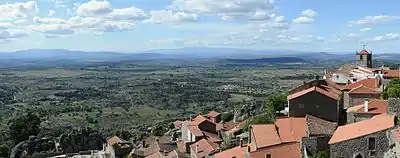Monsanto (Idanha-a-Nova)
Monsanto is a village and a former civil parish in the municipality of Idanha-a-Nova, Portugal. In 2013, the parish merged into the new parish Monsanto e Idanha-a-Velha.[1] It covered an area of 131.76 km² and had 828 inhabitants (June 30, 2011). It was the principal town of the concelho between 1174 and the beginning of the 19th century, and the county seat in the period of 1758-1853. In recent decades, Monsanto has become popularly known as "the most Portuguese village of Portugal" in a class of twelve classified historic villages in Portugal. The emblem of Portugal, the Silver Rooster (Galo de Prata), designed by Abel Pereira da Silva, can be seen atop the Clock Tower or Lucano.

The mountain Monsanto (Latin: Mons Sanctus) rises abruptly to the East of the Idanha-a-Nova up to 758 meters above sea level.
The earliest traces of man is from Early Stone Age at the time of the ice-ages. Later, Romans settled at the base of the mountain. Also traces from Visigoth in the early Middle Ages and even earlier Arab presence has been found in the area.
In the 12th century, King Afonso I of Portugal conquered Monsanto from the Moors as part of the Christian Reconquista. In 1165, he granted the custody of the city to a knights' order of the church, first to the Order of Knights Templar, and later to the Order of Santiago. The city was given to the military orders to maintain the reconquered city with Christian hands, and Grand Master the Order of Knights Templar, Gualdim Pais, was manager of the building of the fortress. Later, King Sancho I of Portugal reconstructed and repopulated it after the wars with the Leonese. Unfortunately, the medieval castle was destroyed in the nineteenth century because of an explosion in the ammunition depot of the castle.
The mountain rock is granite, which also the historic and present village is built upon in a fusion of nature and its landforms. This fusion can be seen in the uses of caves and rocks being converted into construction parts.
Places
- Castle of Monsanto
- Chapel of Saint Peter de Vir à Corça o Chapel of Saint Peter de Vira-Corça
- Roman archaeological site of Saint Lawrence
- Old village of Monsanto
- Pillory of Monsanto
- Tower of Lucano
- Chapel of Our Lady of Azenha
- Chapel of Our Lady of the Foot of the Cross
- Chapel of Saint Mary of the Castle
- Chapel of Saint Anthony
- Chapel of Saint Joseph
- Chapel of Saint Michael of the Castle
- Chapel of Saint Sebastian
- Chapel of the Holy Spirit
- Ferreiro Fountain
- Church of Mercy of Monsanto
- Parish Church of Monsanto or Church of the Saint Savior
- Solar of the Marquis of Graciosa Family (Posto de Turismo do Monsanto)
- Solar of Melo Family or Solar of the Counts of Monsanto
- Solar of Pinheiro Family or Solar of the Mono Fountain
- Solar of the Priors of Monsanto
References
- Diário da República. "Law nr. 11-A/2013, pages 552 58-59" (pdf) (in Portuguese). Retrieved 23 July 2014.
External links
![]() Media related to Monsanto at Wikimedia Commons
Media related to Monsanto at Wikimedia Commons
- The Monsanto's freguesia
- Radio Clube of Monsanto
- History of Portugal at Wikipedia History of Portugal
